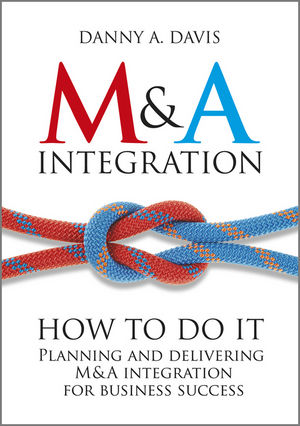
M&A Integration : How To Do It. Planning and Delivering M&A Integration for Business Success
Authors:
Danny A. Davis
Year:
2012
Month:
September
Publisher:
John Wiley
ISBN:
978-1-119-94486-7
The flurry of M&A deals announced in 2011, including AT&T’s agreement to acquire T-Mobile USA, ConAgra’s proposed bid for Ralcorp, and eBay’s acquisition of GSI Commerce, indicate that M&A has returned, and is perhaps headed back to the levels seen before the financial crisis.
Most firms of a certain size will turn to it in their search for growth, forcing almost all managers to face up to the challenge of integration at some point their career. For many managers it is often their first, and only time and M&A is high on the list of things that many managers hate. According to many studies, 50 to 75% M&A transactions turn out to be a failure. One of the main reasons for failure is late or wrong integration or bad integration management. There is a significant demand for more information on best practice in Post Merger Integration.
This book intends to equip those managers for the task…
Danny Davis demonstrates how to handle the post-merger integration process and show how to restructure, consolidate, reduce costs, create efficiencies and perform M&A, from smaller transactions to mega-mergers. The focus is on integration planning and delivery. The book combines a general/strategic view with detailed information of how to actually conduct a Post Merger Integration via very practical tools and check lists that will prove essential in delivering change before, during and after transactions as well as to ensure their success.
Table of Contents
PREFACE xi
ABOUT THE AUTHOR xv
INTRODUCTION xvii
PART I THE STRATEGIC DRIVERS 1
1 M&A OVERVIEW 3
Chapter summary 3
What types of M&A are there? 3
How much should we pay? 5
Most mergers fail 7
Dene success 10
The M&A process 10
Strategic M&A process 14
Strategy: linking pre-deal and post-deal strategy 15
2 INTEGRATION OVERVIEW 19
Chapter summary 19
Integration objective 20
What is integration? 21
Integration strategies 22
Reason for success 23
Will we succeed? 27
Learning from mergers 28
Different mergers at different stages of the company life cycle 33
What should we expect during the integration? 34
Transforming the business 36
3 PLANNING FOR INTEGRATION 39
Chapter summary 39
Model for integration planning 40
Integration checklist 44
What is 100 day planning? 45
Day 1 58
Information 61
Bringing the companies together 63
Planning for “the dip” in productivity and service 64
Review integration readiness 67
4 INTEGRATION DRIVERS 71
Chapter summary 71
What a re synergies? 72
How deep to cut 74
The principles of integration 75
Budget for integration 83
Integration tracking 85
2nd wave integration 86
5 INTEGRATION GOVERNANCE OR STRUCTURE 89
Chapter summary 89
Put people in place 90
Responsibility and accountability 93
Controls in place at different levels 94
Board tracking of integration 94
Agree reporting requirements 95
Teaching integration in our company 98
Integration standards, tool kits, process 99
Risk workshop and risk management 100
Track progress 104
6 DELIVERY – “INTEGRATION MANAGEMENT” 109
Chapter summary 109
Mobilize a merger team 110
Strategic delivery of integration 110
Roll out new procedures for managing projects 111
Integration Management O= ce 113
Integration management 115
Strategic plans, parallel planning process, detailed plans 120
PART II THE FUNCTIONS 125
7 FINANCE 127
Chapter summary 127
Links with other parts of the integration 128
Finance readiness review 130
Financial integration strategies 132
Learning points for ” nance 136
Outsourcing 137
Financial basics 141
Financial risk management 144
Benchmarks, key performance indicators 144
What infrastructure is needed? 145
Finance organization – people 146
Processes and IT 146
8 IT 151
Chapter summary 151
IT perspective day 1 152
Assess readiness for integration 152
IT and integration strategy 154
Reasons for change in IT during a merger 156
Level of integration 157
Links with other parts of the integration 158
Issues during an integration 162
Do the basics 168
Integrate or consolidate systems 172
IT integration success 173
IT integration checklist 177
9 HUMAN RESOURCES 179
Chapter summary 179
HR for the integration (outside HR) 180
HR checklist 199
HR for the HR integration 200
10 COMMUNICATIONS 205
Chapter summary 205
Management communications 208
Communications overview 210
Communications for the whole integration 214
Communications perspective day 1 219
The integration of communications 220
11 SALES AND MARKETING 223
Chapter summary 223
Links with other parts of the integration 226
Sales and marketing overview 227
Brand 235
Culture of sales and marketing 239
Communication planning 240
Integration of sales 241
Integration of marketing 243
Customer perspective day 1 244
Revenue generation 245
12 SUPPLY CHAIN 249
Chapter summary 249
Supply chain perspective day 1 250
Level of integration – how far to integrate 250
Links with other parts of the integration 250
Operating synergies 254
Process review 256
Management controls 257
Supply chain overview 258
Revenue 264
13 HEAD OFFICE AND PROPERTY 267
Chapter summary 267
Head once consolidation 268
Property, level of integration – how far to integrate 269
Property integration 270
14 PROCUREMENT, R&D, LEGAL, HSSE 273
Chapter summary 273
Procurement 273
R&D 277
Legal 280
HSSE (Health, Safety, Security, Environment) 281
15 BOOK SUMMARY 283
Tying it all together 283
The “chain of events” 283
Could we be better prepared for our integration? 284
The killer insights for integration 284
APPENDICES 293
APPENDIX 1 – INTEGRATION TRAINING 295
APPENDIX 2 – CULTURE DIFFERENCE
ASSESSMENT 297
APPENDIX 3 – PEOPLE IN THE BOOK 299
INDEX 301
